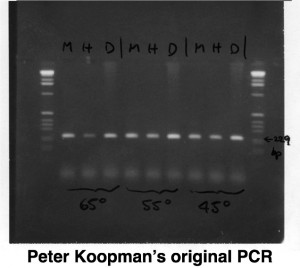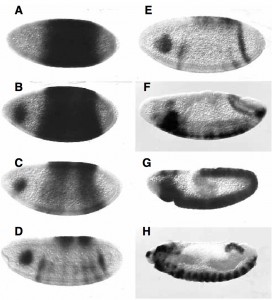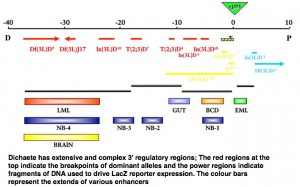 It’s Dichaete’s 100th Birthday today. Discovered by Calvin Bridges on 3rd July 1915: “Among the offspring of one such pair-mating, Bridges found a single female whose wings were extended at a wide angle and elevated (culture 1817, July 3, 1915). Besides the divergent wing character there was present also a bristle character. Only the two posterior dorso-central bristles remained, the two anterior bristles being entirely absent. These features were so sharply defined that it seemed probable that they were the result of mutation.” Bridges & Morgan (1923) Pubs Carnegie Inst 327:p128.
It’s Dichaete’s 100th Birthday today. Discovered by Calvin Bridges on 3rd July 1915: “Among the offspring of one such pair-mating, Bridges found a single female whose wings were extended at a wide angle and elevated (culture 1817, July 3, 1915). Besides the divergent wing character there was present also a bristle character. Only the two posterior dorso-central bristles remained, the two anterior bristles being entirely absent. These features were so sharply defined that it seemed probable that they were the result of mutation.” Bridges & Morgan (1923) Pubs Carnegie Inst 327:p128.
Rush forward to 1995 & we demonstrate that Dichaete encodes a Sox domain transcription factor that has since kept us in business for 20 years. An honourable mention has to go to Peter Koopman who first generated a PCR product using SRY primers from fly DNA we sent him (see below). Initially skeptical, we quickly found that the PCR fragment did in fact identify a single copy fly gene – as soon as I saw the 1st in situ expression patterns I fell in love and our work on Dichaete began. Thanks to Natalia Sanchez-Soriano, Paul Overton, Lisa Meadows, Carol McKimmie, Gertrude Woerfel, Stephan Ohler, Adelaide Carpener, Shi Pei Shen, Jelena Aleksic, Enrico Fererro, Sarah Carl and Josh Maher, along with the host of undergraduate project students who have worked on understanding the role Sox genes play in fly development over the years. Most of all, of course, Michael Ashburner, who unfailingly and generously supported our work for many years.
One of the things I love about working on the fly is the strong link with the history of Genetics. In the lab, and in many labs around the world, the direct descendants of the Dichaete chromosome from the single female Bridges found 100 years ago are still in use as a valuable 3rd chromosome dominant marker.

Peter’s original Polaroid of the PCR with Sry DNA binding domain primers
Note the same size band with human, mouse and fly DNA at the highest annealing temperatures – it’s very conserved !
When I did the 1st in situ hybridisations it was love at first sight! When we (simultaneously with John Nambu’s lab, who sadly died last year) showed it was required for segmentation and CNS development, my love of Sox was cemented.
My only single author research paper showed that ectopic expression of the Sox protein led to dominant wing hinge phenotypes
Dichaete turned out to be interestingly complex with extensive 3′ regulatory regions which we were able to map with the aid of dominant mutation breakpoints.
Here is a list of our Dichaete-related papers
- Russell SRH, N Sanchez Soriano, CR Wright and M Ashburner (1996). The Dichaete gene of Drosophila melanogaster encodes a SOX-domain protein required for embryonic segmentation. Development. 122: 3669-3676.
- Sanchez Soriano N and S Russell (1998). The Drosophila SOX-domain protein Dichaete is required for the development of the central nervous system midline. Development 125: 3989-3996.
- Sanchez Soriano N. and S Russell (2000) Regulatory mutations of the Drosophila Sox gene Dichaete reveal new functions in embryonic brain and hindgut development. Dev Biol 220: 307-321.
- Russell S. (2000) The Drosophila dominant wing mutation Dichaete results from ectopic expression of a Sox-domain gene. Mol. Gen. Genet 263: 690-701.
- Overton PM, Meadows LA, Urban J and S Russell. (2002) Evidence for differential and redundant function of the Sox genes Dichaete and SoxN during CNS development in Drosophila. Development 129: 4219-4228
- McKimmie C, Woerfel G and S Russell (2005) Conserved genomic organization of group B Sox genes in insects. BMC Genetics. 6: p26.
- Phochanukul N. and S Russell. (2010) No backbone but lots of SOX: the invertebrate SOX family. Int. J. Bioch. Cell Biol. 42: p453-464
- Shen SP, Aleksic J, Russell S (2013) Identifying targets of the Sox domain protein Dichaete in the Drosophila CNS via targeted expression of dominant negative proteins. BMC Dev Biol 13: 1.
- Aleksic J, Fischer B, Ferrero E, Russell S. (2013) The role of Dichaete in transcriptional regulation during Drosophila embryonic development. BMC Genomics 14: 861
- Ferrero E, Fischer B, Russell S (2014) SoxNeuro orchestrates central nervous system specification and differentiation in Drosophila and is only partially redundant with Dichaete. Genome Biology 15:R74
- Carl SH, Russell S (2015) Common binding by redundant group B Sox proteins is evolutionarily conserved in Drosophila. BMC Genomics 16:292.



Leave a Reply